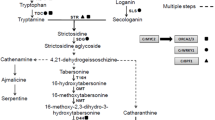Abstract
Aminoethoxyvinylglycine (AVG) applied as a droplet (3 μl, 0.1 mM) to the plumule of seedlings of both the short-day plantChenopodium rubrum and the long-day plantChenopodium murale counteracted to a great extent or even canceled the inhibition of flowering due to exogenous indole-3-acetic acid (IAA). This effect was more pronounced with the two substances administered simultaneously than with later application of AVG alone. AVG by itself in some cases promoted the percentage of flowering in bothChenopodium species. Application of IAA to the shoot apex was shown to elevate ethylene production in both species, whereas application of AVG alone was shown to suppress it. Thus, ethylene may be considered an active agent of flowering inhibition brought about by IAA application.
Similar content being viewed by others
References
Amrhein N, Schneebeck D (1980) Prevention of auxin-induced epinasty by α-aminooxyacetic acid. Physiol Plant 49:62–64
Blake TJ, Reid DM, Rood SB (1983) Ethylene, indoleacetic acid and apical dominance in peas: A reappraisal. Physiol Plant 59:481–487
Khatoon S, Seidlová F, Krekule J (1973) Time-dependence of auxin and ethrel effects on flowering inChenopodium rubrum L. Biol Plant 15:361–363
Krekule J, Přívratský J (1974) The shoot apex as the site of an inhibitory effect of applied auxin on photoperiodic induction of flowering in the short-day plantChenopodium rubrum L. Z Pflanzenphysiol 71:345–348
Krekule J, Pavlová L, Součková D, Macháčková I (1985) Auxin in flowering of short-day and long-dayChenopodium species. Biol Plant (in press)
Lang A (1961) Auxins in flowering. In: Encyclopedia of plant physiology XIV. Springer-Verlag, Berlin, pp 909–958
Lieberman M (1979) Biosynthesis and action of ethylene. Annu Rev Plant Physiol 30:533–591
Mulkey TJ, Kuzmanoff KM, Evans ML (1982) Promotion of growth and hydrogen ion efflux by auxin in roots of maize pretreated with ethylene biosynthesis inhibitors. Plant Physiol 70:186–188
Přívratský T, Tykva R, Krekule J (1976) The possible role of auxin in reversing photoperiodic induction of flowering in a short-day plant,Chenopodium rubrum L. Z Pflanzenphysiol 78:377–386
Seidlová F, Khatoon S (1976) Effects of indol-3yl acetic acid on floral induction and apical differentiation inChenopodium rubrum L. Ann Bot 40:37–42
Ullmann J, Seidlová F, Krekule J, Pavlová L (1985)Chenopodium rubrum as a model plant for testing the flowering effects of PGRs. Biol Plant (in press)
Yang SF, Hoffman NE (1984) Ethylene biosynthesis and its regulation in higher plants. Annu Rev Plant Physiol 35:155–189
Author information
Authors and Affiliations
Rights and permissions
About this article
Cite this article
Macháčková, I., Krekule, J., Součková, D. et al. Reversal of IAA-induced inhibition of flowering by aminoethoxyvinylglycine inChenopodium . J Plant Growth Regul 4, 203–209 (1985). https://doi.org/10.1007/BF02266958
Received:
Accepted:
Issue Date:
DOI: https://doi.org/10.1007/BF02266958




